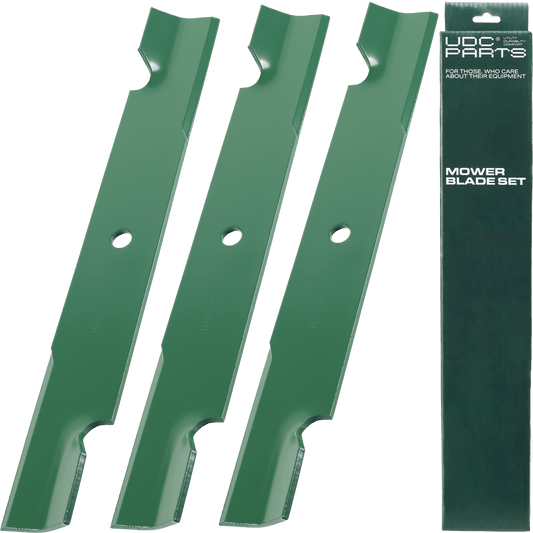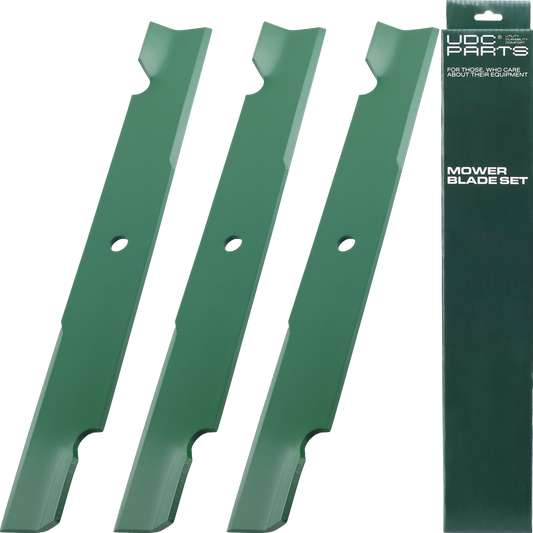
Selecting blades for your lawn mower is an extremely important action. Lawn mower blades can be categorized into four main types, each designed to meet specific mowing needs. In this write-up, we'll look at all the types of mower blades that could potentially work for you.
Why Choosing the Right Mower Blade Matters
What type of mower blade is best? Well, you need to find blades that are not only suitable for your machine, but also perfectly “compatible” with your lawn. The cut should be easy to make without damaging the grass. The grass itself should be easy to recover from the work and continue to grow. Mowing is not only about removing excess grass, but also about maintaining a healthy lawn.
Types of Lawn Mower Blades
You can choose from the following types of lawn mower blades: standard blades, high-lift blades, low-lift blades, mulching blades or shredding blades.
Standard Blades
A type of blade for basic needs that your lawnmower was most likely originally equipped with. They are suitable for lawns on level ground and without tall grass. They are also not suitable for mowing in rain.
High-Lift Blades
One of the main differences in lawn mower blades is the ability to lift the grass when mowing. Blades with a high lift have a steeper angle, which gives them the ability to cut the grass more efficiently and with more force, which will be extremely useful when using a bagged mower. Servicing these blades requires machinery with a powerful motor, and they are also not very suitable for use on sandy terrain.
Low-Lift Blades
This type of blade is ideal for mowing on sandy soil. Thanks to the low lift, the cuttings are not lifted high, but are thrown aside. By favoring this particular mower blade type, you will also solve the problem with dust lifting. The unambiguous advantages of low-lift blades include durability, quieter operation, and less strain on the mower engine itself.
Mulching Blades
This type of blade is also known as a multifunction blade and is the ideal choice if you do not intend to clean up the grass after mowing. In this case, the grass is shredded in the process, tossed onto the deck and then blown away from there, settling back on the lawn and thus can serve as fertilizer. This type of blade will not give you great performance with high or dense grass.

Shredding Blades
These blades have a special toothed edge and are suitable for several types of grass collection at the same time: mulching, bags, side discharge. As in the case with the previous type of blades, the disadvantages include the extreme inefficiency of work with dense grass, as well as the high level of noise generated.
How to Choose the Right Blade for Your Yard
Different types of lawn mower blades are needed for different types of yards. Factors such as the material of manufacture as well as the optimum cost of the blades are also important.
Consider Your Lawn’s Needs
Your choice should be based primarily on the type of lawn you have, the way the grass is harvested, and the terrain. Carefully examine the condition of your soil as well as the grass cover before replacing old blades.

Mowing Frequency and Conditions
Depending on the type of grass, it's better to mow every 5-7 days (Kentucky bluegrass, fescue) or every 7–10 days (Bermuda, Zoysia grass types) or make decisions based on growth characteristics. It is better to mow only dry grass, and the best time for that is early morning or late evening. Make sure that the blades are always sharp.
Compatibility with Your Mower Model
At UDC Parts, we've done our best to help you find a compatible part as quickly as possible. Use the search on the website, or simply search for your model in the product description.
Blade material
In addition to the lawnmower blade types, the material of manufacture can also vary. There are usually three possible materials: high-carbon steel, stainless steel and aluminum. The first option is the most common in terms of reliability/quality, the second material should be chosen if your blades for one reason or another deal with water, and the third in case of not the most frequent use.
Price vs. Quality
Quality blades can last you about 400 hours and will greatly save you valuable time in terms of both sharpening and replacing consumables.
How to Maintain Different Mower Blades
It is uniform for all to regularly check for damage and to observe safety rules when you are producing replacement. Completely disconnect the appliance from the power supply in such situations.
Sharpening and Balancing Tips
A general rule of thumb for all types of lawnmower blades is to sharpen them every 20–25 hours of use. Use a nail or similar support to check the balance. If there is a misalignment to one side, this is the side you need to work on with the appropriate tool kit.
When to Replace Mower Blades
Depending on the difference in mower blades material as well as the quality of the blades, they can last from 100 to 400 hours of use.
Proper Storage and Care
Always clean grass and other debris and water particles from the blades before starting the lawn mower in the storage area and regardless of the lawn mower blade types used.

Get Expert Lawn Care Tips from UDC Parts
Make a profitable purchase and get your bonuses by purchasing 2 or more sets of blades on our website. These spares will be useful to you in any case.
Conclusion
With all this information you can now answer the question: what type of mower blade is best. The basis for the answer: a thorough examination of your lawn.





















